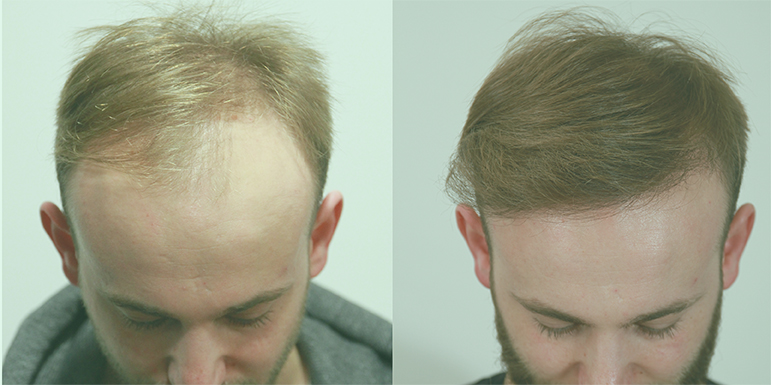
FAT Hair Transplant
FAT hair transplantation is a hair transplantation method performed in combination with the FUE technique, in which stem cell-rich adipose tissue prepared from the patient's own adipose tissue is injected into the scalp before the procedure. The aim here is to improve the function of the hair follicles. FAT Hair transplantation is derived from the first letters of the words FAT, which means fat in English, and Follicular unit Autologous Transplantation. The oil used in FAT hair transplantation has many benefits:
- Supporting hair follicle function
- Fighting the progression of hair loss,
- Increase hair growth,
- To support the healthy, natural growth and adhesion of the transplanted hair
- Increase wound healing
- Strengthen existing miniaturized hair
- Preparing the skin for the procedure during hair transplantation
How is FAT Hair Transplantation Performed?
FAT Hair transplantation is a 4-stage application:
1. Planning
The patient's existing fat accumulation and where the fat will be harvested are checked. Hairline, crown area, donor area controls and drawings are made.
2. Liposuction:
On the day of hair transplantation, some fat is taken from the patient's abdomen by lipoaspiration. The fat is processed and made rich in stem cells.
3. Injection of autologous adipose tissue:
The prepared fat tissue is injected into the patient's scalp.
4.Hair Transplant:
In the classical sense, FUE hair transplantation begins. The grafts taken from the donor area are transplanted one by one to the area to be transplanted.
Create a preliminary interview request for all your questions about Hair Loss and PRP procedures.
Scientific
Safe
Effective
FAT Hair Transplant and Scientific Articles
Hair loss, hair sparseness and balding are quite common, but the number of scientifically based articles is quite limited due to the lack of any health problems caused by hair loss. Current hair loss treatments are mostly medications used to reduce the risk of systemic side effects, laser treatments and hair transplantation, which is recognized as the most effective method today. For this reason, many researchers, including me, are constantly looking for new and alternative treatments.
There has been a lot of research supporting the role of adipose tissue, especially autologous fat, the patient's own fat, on the hair growth cycle. Autologous fat, or fat transfer, has been used mainly in aesthetic applications, regenerative medicine and reconstructive surgery for volume effect. However, as a result of the presence of stem cells in the fat and the feedback provided by the researches, we have understood that these stem cells provide many advantages to the scalp. When we examine all these scientific researches, a common conclusion emerges:
- Autologous fat injection is a potential technique that can be used to promote hair growth.
- This was discovered coincidentally by observing the effects on hair growth after autologous fat transplantation.
- In addition to volumizing, some surgeons have reported that after fat transfer, patients' skin tissues are refreshed and they notice a positive change in their hair.
- Many studies on the application of adipose-derived mesenchymal cells have shown that autologous adipose tissue transplantation is safe and effective and can be used as an effective cell-based therapy.
In conclusion, treatment using adipose tissue as the most readily available source of mesenchymal stem cells seems to be very effective for alopecia and hair loss. This could be a new treatment option for hair regeneration. Adipose tissue has great potential for hair regeneration by enhancing the growth of healthy hair.

Results
FAT When we look at the clinical studies of the oil we use in hair transplantation:
- FAT In fat grafting for hair transplantation treatment, the risk of fat embolism is very low because the amount of fat harvested and transferred is very low.
- In one study, in 27 patients with female pattern hair loss, hair density increased from 105.4 to 122.7 hairs per cm, while their thickness increased from 57.5 to 64.0 mm.
- In the study by Fukuoka et al., the mean increase in the number of hairs in men and women was 29±4.1 and 15.6±4.2, respectively, and the number of hairs was significantly higher than those who did not undergo fat transfer.
- In another study by Fukuoka et al. in 2017, they reported improved hair quality and a significant difference in the number of hairs increased between treatment and placebo.
- In Gentile et al's study, 23 patients with Norwood 3 to 5 (this was the first study to perform fat transfer on male androgenic alopecia) were treated with stem cells (HFSCs). Their results were compared with placebo 23 weeks after treatment.
- In the study by Anderi et al, the effect of stem cells was evaluated on 20 patients (9 women and 11 men) with hair loss alopecia areata. After lipoaspiration, stem cell-rich oil was transferred to the patient's scalp and the results were measured by three clinical tests: hair quality, pull test and hair density. Hair density (85.1±8.7 vs 121.1±12.5 hair/cm 2 ), hair diameter (60.5±1.8 vs 80.8±2.4 μ) and pull test values (4.4±0.3 vs 0.8±0.2)]. In this study, the results showed that autologous adipose tissue transplantation is safe and effective and can be used as an effective cell-based therapy for treatment.
"In conclusion, treatment using adipose tissue as the most readily available source of mesenchymal stem cells appears to be very effective for alopecia and hair loss and may be a new treatment option for hair regeneration. Adipose tissue has a great potential for hair regeneration by enhancing the growth of healthy hair." is the common point of all the researches conducted and their concluding statement;
- It shows a significant improvement in hair growth 6 months after treatment.
- The injected fat tissue releases growth factors and stimulates vascularization,
- Promotes the formation of new capillaries,
- Increases hair production and improves blood supply to the scalp
- Creating a perfect environment for hair follicles
- Promotes new and healthy hair
conclusions such as.
